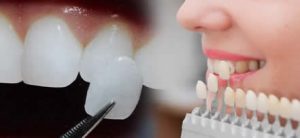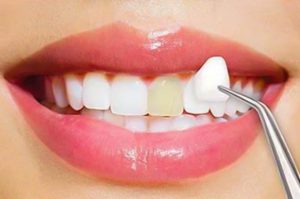Lumineers® “no-prep veneers”
Lumineers® are a special type of porcelain veneers that are made exclusively by DenMat dental laboratory. They are commonly referred to as “no-prep” veneers. This is because, in contrast to traditional porcelain veneers, Lumineers® usually don’t require the removal of tooth structure. Now, you might think to yourself “this sounds great, why wouldn’t everyone get Lumineers® over veneers?” In order to answer this question, you need to understand the pros and cons of Lumineers®. Let’s take a closer look at how Lumineers work so you can better compare them to other cosmetic dentistry procedures:

Applications for Lumineers®
Lumineers® can address many different cosmetic concerns:
- Lumineers® are perfect for correcting that one snag front tooth
- They can also be used to fix color mismatches on your front teeth so you can finally get rid of that one tooth that’s always sticking out
- You can even correct stains, enamel wear, small gaps, and many other minor dental discrepancies simply by putting Lumineers® on your front teeth
Lumineers are made from high-quality laminate, meaning that they maintain their beautiful appearance many years. While they may not always be permanent, you’re likely to get a good decade or two of dazzling smiles from well-placed Lumineers®.
What are the benefit of Lumineers® over porcelain veneers?

The biggest advantage of Lumineers® over porcelain veneers is that Lumineers® require almost no reduction of tooth structure. All your dentist has to do is take an impression of your teeth and send them to the laboratory. Your Lumineers® arrive within a few weeks, your dentist cements them in place, and your new smile is all set to conquer the world! In contrast to this, preparing your teeth for porcelain veneers requires the removal of significant tooth structure. You also don’t need to get numb for Lumineers® wheras porcelain veneers typically require several shots (painful ones too!) Overall, Lumineer® treatment is a much simpler process as compared to porcelain veneer treatment.
What are the disadvantages of Lumineers® as compared to porcelain veneers?
The main disadvantage of Lumineers® is that they are not as long-lasting as porcelain veneers. For one, Lumineers® are more likely to chip, break, or fall off of your teeth. They’re also susceptible to losing their initial luster over the years. As your teeth continue to stain and darken, your Lumineers® can also change color. This is because Lumineers® are so thin that they don’t fully block out your tooth color from showing through. Finally, placing Lumineers® on your teeth can make them appear bulky in some occasions. The fact that there is almost no tooth removal also means that there’s less room to correct issues with your smile. As a result, while Lumineers® can look very appealing, they are usually not as attractive as porcelain veneers are.
What are the alternatives to Lumineers®?

There are several acceptable alternatives to Lumineers®, depending on what you’re looking for and your budget:
- Snap-on-smile®: The least expensive alternative to Lumineers® are Snap-on-smile® (also made by DentMat). Snap-on-smile® is a removable set of teeth that resembles porcelain veneers or Lumineers®. However, Snap-on-smile® goes in and out of your mouth and they are likely to break over time. Overall, Snap-on-smile® is designed more for temporary use than for daily wear.
- Dental bonding: A second alternative treatment to Lumineers® is dental bonding. Dental bonding is permanent. It’s also less expensive than Luimineers® since there’s no lab costs involved. However, dental bonding changes color rapidly since bonding can scratch and gather stains. Lumineers® on the other hand, tend to hold up their shape and color over the years much better than dental bonding does.
- Porcelain veneers: Finally, the last alternate to Lumineers® is porcelain veneers. Porcelain veneers usually look nicer than Lumineers® since they are thicker and block out the tooth color. They also lost longer than Lumineers® and most porcelain veneer cases never require a redo. Also, porcelain veneers can actually correct underlying dental problems whereas Lumineers® only mask them. However, porcelain veneers are a more complex treatment, they’re irreversible, and are more expensive than Lumineers®.
How much do Lumineers® usually cost?
Lumineers® typically cost just a bit less than porcelain veneers. They don’t cost much less either, as you’re still looking at somewhere around $1,000 per tooth (depending on where you seek treatment). If you’re just trying to fix a single tooth, then one Lumineer® is all you need. However, most people decide to place Lumineers® on their front 6 to 10 teeth and the costs can add up. As you can see, Lumineer® treatment is not cheap by any means. Then again, beautifying your smile and shaving a decade from your appearance is worth the money to those who decide to go for Lumineers®!
How do I get Lumineers® on my teeth?

You can only get Lumineers® from a local dentist who’s certified in Lumineers® technology. Look for a dentist who has a good track record, with plenty of cosmetic dentistry experience. Consider using our dentist Search Engine if you’re searching for a good cosmetic dentist near you. You can find dentist near you, read their reviews, view their treament photos, check out their list of services, and even book your appointment all online from one convenient place. Let’s find a great dentist near you today to see if you are a good candidate for rejuvenating your smile with Lumineers®!
0 Comments